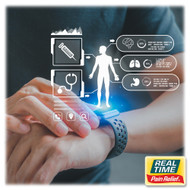Health Wearables: Revolutionizing Chronic Disease Management and Prevention
Posted by Dennis R. Escalera on 1st Apr 2024
The landscape of healthcare is witnessing a significant transformation with the advent of health wearables, a technology that is redefining the paradigms of chronic disease management and prevention. These devices, ranging from smartwatches and smart clothes to implantable sensors, are empowering individuals to monitor their health metrics, including physical activity, heart rate, and sleep patterns, in real-time. This evolution in personal health technology is paving the way for a more proactive and personalized approach to healthcare, emphasizing prevention over treatment.
Empowering Individuals with Real-time Health Data
Health wearables provide a continuous stream of health data, enabling individuals to gain insights into their physical condition and lifestyle habits. This data-driven approach to health monitoring allows for the early detection of potential health issues, facilitating timely interventions that can prevent the progression of chronic diseases. For instance, monitoring heart rate variability and patterns can help to identify cardiovascular conditions early, while tracking sleep patterns can offer insights into sleep disorders and their implications on overall health.
Enhancing Chronic Disease Management
For individuals with chronic conditions, health wearables can actively manage their health. Devices that monitor blood glucose levels continuously, for example, are revolutionizing diabetes management by providing patients and healthcare providers with detailed information necessary to tailor treatment plans. Similarly, wearable blood pressure monitors allow for the monitoring of hypertension, enabling adjustments to medication and lifestyle to better manage the condition.
Smart Clothes and Implantables: The Next Frontier
Beyond conventional wearables like smartwatches, the development of smart clothes and implantable devices represents the next frontier in health technology. Smart garments equipped with sensors can monitor vital signs and body movements, offering detailed insights into an individual's health status and physical performance. Implantables, such as microchips, can monitor specific health metrics from within the body, promising even greater precision in health monitoring, heralding a future where healthcare seamlessly integrates into our daily lives.
The Role of Wearables in Preventive Healthcare
By enabling the continuous monitoring of health metrics, wearables play a crucial role in preventive healthcare. The ability to track physical activity levels, for example, encourages individuals to adopt a more active lifestyle, reducing the risk of obesity and related chronic conditions. Moreover, the insights gained from wearables can encourage preventive measures tailored to individual health profiles, promoting a holistic approach to health and wellness.
Challenges and Considerations
Despite the potential of health wearables, their widespread adoption is not without challenges. Issues related to data privacy and security, the accuracy of health data, and the digital divide that may limit access for some people are among the considerations that need addressing. Moreover, integrating wearable health data into clinical practice requires healthcare systems to develop standardized protocols and adapt to this new data source.
Conclusion
The emergence of health wearables represents a pivotal shift towards a more personalized and preventive healthcare model. By equipping individuals with the tools to monitor and manage their health, wearables are transforming the management of chronic diseases and empowering a healthier, more informed society. As technology advances, the potential of wearables in healthcare will continue to expand, promising a future where health monitoring and disease prevention integrate into our everyday lives.
References
- Proclinical Blogs. "Top 10 new medical technologies of 2022." Available at: proclinical.com/insights/2022-02-10/top-10-new-medical-technologies-of-2022
- World Economic Forum. "The rise of wearable technology in healthcare." Available at: weforum.org/agenda/2021/01/rise-wearable-technology-healthcare/





